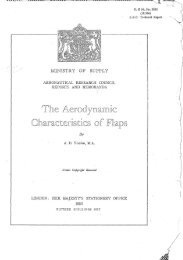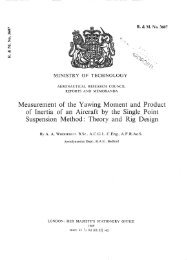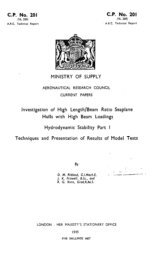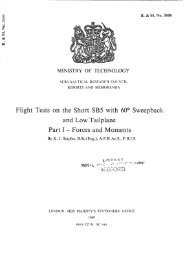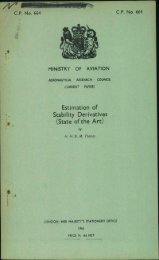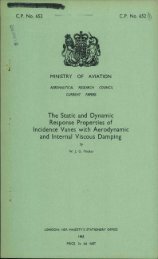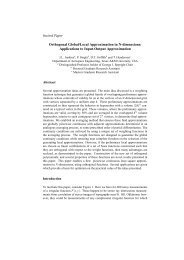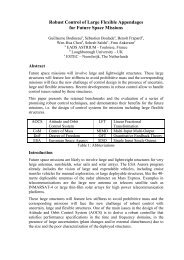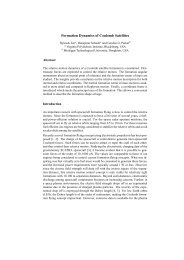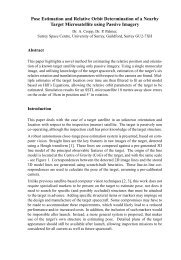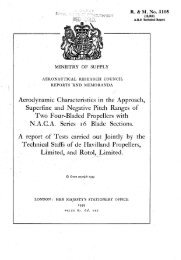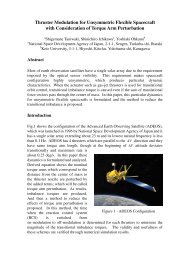A Survey of Unsteady Hypersonic Flow Problems
A Survey of Unsteady Hypersonic Flow Problems
A Survey of Unsteady Hypersonic Flow Problems
Create successful ePaper yourself
Turn your PDF publications into a flip-book with our unique Google optimized e-Paper software.
- 30 -<br />
The cut-<strong>of</strong>-phase component <strong>of</strong> Ys is plotted in Fig. 8 and the<br />
cut-<strong>of</strong>-phase component <strong>of</strong> &, is plotted in Fig. 9 in comparison with the<br />
quasi-steady Newtonian result. At practical values <strong>of</strong> kx where 5; = i;/a,<br />
is the non-dimensional amplitude <strong>of</strong> the cap plunging motion, it is clear that the<br />
cut-<strong>of</strong>-phase component <strong>of</strong> the shock wave motion will be negligible over the<br />
range <strong>of</strong> applicability <strong>of</strong> the analysis. The cut-<strong>of</strong>-phase component <strong>of</strong> the<br />
pressure is small for quasi-steady Newtonian theory; the present theory provides<br />
a correction <strong>of</strong> the order <strong>of</strong> .$ at the limit <strong>of</strong> its application.<br />
The analysis by Hclt 33 can be applied to those parts <strong>of</strong> the flow<br />
around a body where supersonic conditions exist, and a characteristic analysis<br />
has been carried cut. Starting from an established flow field and known<br />
characteristic directions, Hclt expresses the flow equations in terms <strong>of</strong> a<br />
cc-ordinate system based on the given characteristic directions and introduces<br />
small perturbations <strong>of</strong> the flow quantities. If squares and products <strong>of</strong> the<br />
perturbation quantities are neglected, the equations become linear equations<br />
for the perturbations with coefficients determined by the steady flow solution.<br />
Hclt applied this analysis to the simple case <strong>of</strong> isentropic flow over an<br />
axisymmetric conical afterbody in Ref. 33. More recently, Kawamura and Tsienx<br />
applied the method <strong>of</strong> analysis to an axisymmetric body to determine the stability<br />
derivatives, but this is for, effectively, steady state conditions.<br />
The small perturbation methods <strong>of</strong> solution can be valid only when the<br />
conditions are such that the hypersonic similarity parameter for the body motion,<br />
M6 (where 6 is the change in surface slope due to the motion), is small, so<br />
that disturbances to the flow quantities are sufficiently small. In general,<br />
numerical solutions will be necessary, but this is unlikely to be an important<br />
drawback since a numerical solution <strong>of</strong> the steady flow held will usually have<br />
been necessary in the conditions for which the methods are best used.<br />
2.2 The Influence <strong>of</strong> Real Gas Effects and Viscosity<br />
It was pointed cut inAppendix Ithat, in many hypersonic flows,<br />
temperatures will be generated in the gas which are sufficient to cause excitation<br />
<strong>of</strong> vibrational degrees <strong>of</strong> freedom <strong>of</strong> pclyatcmic gas molecules, dissociation,<br />
and icnisaticn; and that these effects can give rise to significant mcdificaticns<br />
to the flow. Fortunately, the characteristic times involved in these reactions<br />
will usually be very short in comparison with the characteristic time <strong>of</strong> any flow<br />
unsteadiness likely to be met in practice. For example, the relaxsticn time<br />
for dissociation <strong>of</strong> cqgen for flow in the stagnation region <strong>of</strong> a blunt body at<br />
M = 15 at 200 000 ft is <strong>of</strong> the order <strong>of</strong> 2 x 10e4 seconds, whereas the maximum<br />
frequency for any unsteady motion involving the structure <strong>of</strong> a vehicle is unlikely<br />
to be as high as 100 cycles per second, and will, usually, be very much less than<br />
this. Consequently, although the effects <strong>of</strong> these changes in the gas can complicate<br />
analysis, they can usually be dealt with on a quasi-steady basis.<br />
The effects <strong>of</strong> viscosity are not as clearly defined. The first effects<br />
that must be considered exist already in steady flow and arise from the fact<br />
that boundary layers are in general very much thicker than at lower Mach numbers<br />
because <strong>of</strong> the rise in the temperature <strong>of</strong> the gas as a result <strong>of</strong> its deceleration<br />
in the layer, and the smaller unit Reynolds numbers associated with high altitude<br />
flight. The thickness <strong>of</strong> the boundary layer can be such that it exerts a<br />
significant influence on the external 'inviscid' flow. A measure <strong>of</strong> this influence<br />
is usually given by the size <strong>of</strong> the parameter x defined by:<br />
x = bf(a,JRe,)' . . . pt)<br />
where/



